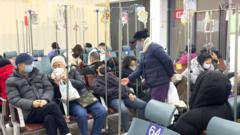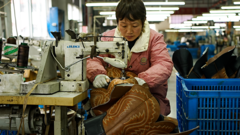Beijing has been witnessing a notable increase in flu-like cases of human metapneumovirus (HMPV), particularly affecting children. This situation has heightened public concern, with viral social media images showcasing crowded hospitals. Health officials have confirmed this trend as a seasonal rise in HMPV cases rather than an impending pandemic. Experts underline that HMPV, identified in 2001, is not a new virus like Covid-19; it has existed for decades and most children have typically been exposed to it by age five.
Understanding the Recent Surge in HMPV Cases in China

Understanding the Recent Surge in HMPV Cases in China
Beijing's hospitals face a seasonal spike in human metapneumovirus affecting children, though experts assure it's not a pandemic threat.
HMPV primarily leads to mild respiratory infections with symptoms such as cough, fever, and nasal congestion for most individuals. However, it poses a greater risk to younger children, especially those under two years old, and immunocompromised individuals, including the elderly. According to infectious diseases specialist Dr. Hsu Li Yang, a small percentage of those with weakened immune systems could develop severe symptoms and may require hospitalization.
The ongoing spike in HMPV cases in northern China is linked to dwindling temperatures typical of late winter and early spring, a time when respiratory viruses thrive. This seasonal increase also aligns with similar trends observed in several northern hemisphere countries, including the US and UK, where health officials reported heightened HMPV activity since last October.
Experts reassure the public that HMPV does not present the same pandemic risk as Covid-19, as it is neither novel nor presents new strains. Instead, natural immunity, built up over years, means that most individuals have some defenses against it due to past exposures. Public health recommendations remain clear: employing standard precautions such as mask-wearing in crowded settings, practicing good hand hygiene, and keeping up with flu vaccinations are sensible measures, particularly for those most vulnerable to severe respiratory infections.
The ongoing spike in HMPV cases in northern China is linked to dwindling temperatures typical of late winter and early spring, a time when respiratory viruses thrive. This seasonal increase also aligns with similar trends observed in several northern hemisphere countries, including the US and UK, where health officials reported heightened HMPV activity since last October.
Experts reassure the public that HMPV does not present the same pandemic risk as Covid-19, as it is neither novel nor presents new strains. Instead, natural immunity, built up over years, means that most individuals have some defenses against it due to past exposures. Public health recommendations remain clear: employing standard precautions such as mask-wearing in crowded settings, practicing good hand hygiene, and keeping up with flu vaccinations are sensible measures, particularly for those most vulnerable to severe respiratory infections.






















